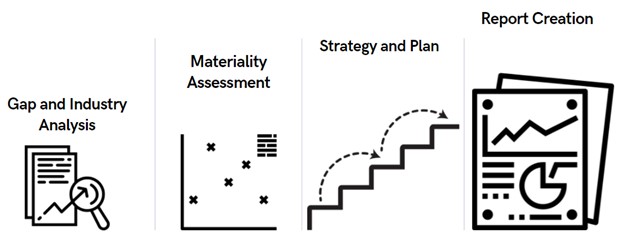Reporting Starts Now
Annual sustainability reporting can be a vehicle for transparent communication of companies’ initiatives, goals, and impacts on their people, the communities in which they engage, the environment, their operations, and supply chains.
An externally facing, value-driven sustainability report begins with internal planning and identification of material topics. Through a well-rounded planning process, companies can gain a deeper understanding of the intersection of their stakeholders’ expectations and their business objectives. This intersection point can drive goals, help set Key Performance Indicators (KPIs), and direct positive change management within their operations.
Each of these components can then be used to create an engaging sustainability report that demonstrates the company’s understanding of its impacts and stakeholders while increasing brand transparency and trust.
Want to proactively communicate your company’s goals and impact? Planning on publishing a 2021 Sustainability Report in Q1 of next year? With the end of year near, now is the time to start preparing so come the new year, you are ready to hit the ground running towards a successful publishing deadline. While the reporting process will look different for every company, the 5 steps below set the foundation for a transparent, measured, and holistic report.
5 Key Steps to Preparing a Sustainability Report
- Materiality Assessment: Know what you should be reporting on by understanding stakeholder expectations and business impacts.
- Baseline Data: Informed by material topics, identify metrics, current performance, and impacts in those topic areas.
- Set Goals: With an understanding of where you stand, what are some measurable and realistic goals in each topic area?
- Make a Plan: How are you going to achieve these goals? What current programs can you leverage and are there new ones to create?
- Align with Standards: With your plan in place, you can now report utilizing GRI, SASB, UN SDGs, or other globally recognized standards for ease of comparability in your industry, as well as for internal progress monitoring and year-on-year comparisons.
How 3R Can Help
3R Sustainability knows the value lies in the process, and the report becomes the final, external communication of the challenging work done within. The consultants at 3R are experts in supporting clients in stakeholder mapping, material impact identification, sustainability planning, and value-add sustainability report creation.
Our interdisciplinary team works alongside our clients to integrate sustainability throughout their organization. Reinforced by our deep technical expertise, the consultants at 3R have a mission to create a direct, measurable impact on environmental, social, governance, and building performance issues. 3R helps companies realize the business value of sustainability and resilience.
The value of 3R work shows up in:
- Managing environmental impacts
- Improving, attracting, and retaining employees
- Better brand reputation and trust
- Strengthened governance and company ethics
- Capitalizing on investment opportunities driven by ESG initiatives
- Enhanced building and portfolio performance
- Safer and healthier working conditions
- Overall enhanced risk mitigation and resiliency
OUR SERVICES:
- ESG Strategy and Plan: Gap and Industry Analysis, Materiality Assessment, Strategy and Plan, Reporting, Process and System Implementation, Program Development, Portfolio Management and Sustainable Investing
- GHG Emissions Reduction: Emissions Inventories, Science-Based Targets, Net Zero Commitments, CDP and Climate-Related Reporting
- Built Environment: Creating assurance for our clients through: Measurement and Verification, Energy Modeling and Auditing, Sustainable Materials Selections, and LEED, BREEAM, and WELL Health-Safety Project Support
Contact us today to learn more about how we can help you support your sustainability initiatives.
